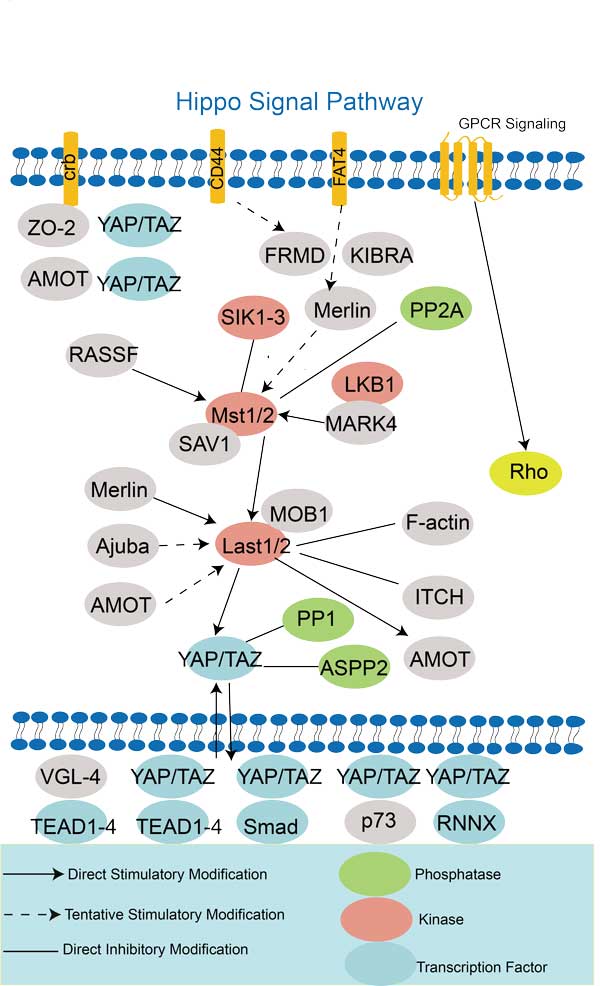SIK2
-
Official Full Name
salt-inducible kinase 2 -
Overview
SIK2 (Salt inducible kinase 2) belongs to the protein kinase superfamily, CAMK Ser/Thr protein kinase family, and AMP-activated protein kinase (AMPK) subfamily, predicted molecular weight 104 kD. SIK2 is found in adipocytes and might be involved in metabo -
Synonyms
SIK2;salt-inducible kinase 2;SNF1 like kinase 2 , SNF1LK2;serine/threonine-protein kinase SIK2;DKFZp434K1115;KIAA0781;LOH11CR1I;QIK;SIK-2;SNF1-like kinase 2;qin-induced kinase;salt-inducible protein kinase 2;salt-inducible serine/threonine kin
Recombinant Proteins
- Human
- Mouse
- Sf9 Cells
- HEK293
- E.coli
- GST
- Non
- His
- T7
- DDK
- Myc
| Cat.# | Product name | Source (Host) | Species | Tag | Protein Length | Price |
|---|---|---|---|---|---|---|
| SIK2-1478H |
Active Recombinant Human QIK, GST-tagged
|
Sf9 Cells | Human | GST | Full length |
|
| SIK2-30089TH | Recombinant Human SIK2 | Human | Non | Full L. |
|
|
| SIK2-415H | Recombinant Human Salt-inducible Kinase 2, GST-tagged, Active | Sf9 Cells | Human | GST |
|
|
| SIK2-1841HCL | Recombinant Human SIK2 293 Cell Lysate | HEK293 | Human | Non |
|
|
| SIK2-1954H | Recombinant Human SIK2 protein, His & T7-tagged | E.coli | Human | His&T7 | Gln655~Val925 |
|
| Sik2-1955M | Recombinant Mouse Sik2 protein, His & T7-tagged | E.coli | Mouse | His&T7 | Ser674~Val916 |
|
| SIK2-3156H | Recombinant Human SIK2 Protein, Myc/DDK-tagged, C13 and N15-labeled | HEK293 | Human | DDK&Myc |
|
|
| Sik2-5878M | Recombinant Mouse Sik2 Protein, Myc/DDK-tagged | HEK293 | Mouse | DDK&Myc |
|
Background
What is SIK2 Protein?
SIK2 gene (salt inducible kinase 2) is a protein coding gene which situated on the long arm of chromosome 11 at locus 11q23. SIK2 protein is a serine/threonine kinase belonging to the AMPK (AMP-activated protein kinase) family. It plays a role in a variety of biological processes, including regulation of fatty acid oxidation, cell proliferation, migration, invasion, and cell metabolism. The SIK2 protein is consisted of 926 amino acids and SIK2 molecular weight is approximately 103.9 kDa.
What is the Function of SIK2 Protein?
It plays a role in a variety of biological processes, including regulation of fatty acid oxidation, autophagy, immune response, and glucose metabolism. In particular, SIK2 phosphorylated the Ser-794 site of IRS1 in insulin-stimulated fat cells, possibly regulating the efficiency of insulin signaling. In addition, SIK2 can inhibit CREB activity by phosphorylation and inhibition of CREb-specific coactivator TORCs, thus affecting cell proliferation, differentiation and metabolism. High expression of SIK2 is also seen in a variety of other cancers, including prostate cancer, breast cancer, lung cancer, etc., and it may play an important role in tumor development or progression
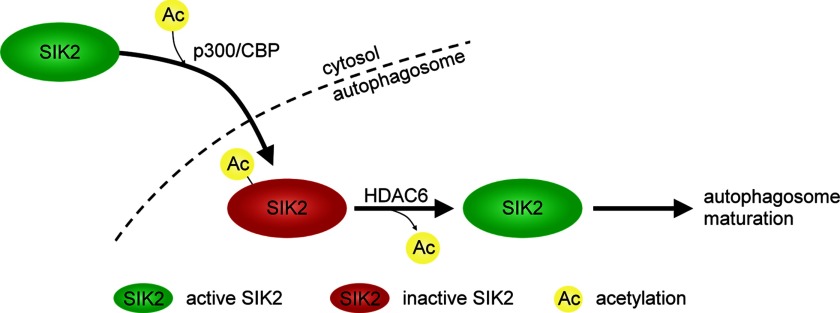
Fig1. SIK2 kinase activity, controlled by an acetylation-based regulatory switch, contributes to the progression of autophagy. (Fu-Chia Yang, 2013)
SIK2 Related Signaling Pathway
In ovarian cancer, SIK2 up-regulates the expression of HIF-1α by activating PI3K/AKT signaling pathway, directly promotes the transcription of glycolysis gene, enhances Warburg effect, and promotes the glycolysis process of tumor cells. SIK2 can promote mitochondrial division and inhibit mitochondrial oxidative phosphorylation by phosphorylation at Ser616 of Drp1 protein, thus affecting the metabolism and survival of tumor cells. In breast cancer cells, SIK2 promotes aerobic glycolysis through the PI3K/AKT/mTOR signaling pathway and induces cisplatin resistance. In gastric cancer, SIK2 inhibits the development of gastric cancer by inhibiting the autophagy degradation of protein phosphatase regulated by this signaling pathway.
SIK2 Related Diseases
SIK2 has been linked to a variety of diseases, particularly metabolic disorders and tumor development. In ovarian cancer, for example, SIK2 enhances the ability of tumor cells to proliferate, invade and metastasize by promoting aerobic glycolysis and epithelial-mesenchymal transformation (EMT). In breast cancer, high expression of SIK2 is associated with cisplatin resistance, possibly through the PI3K/AKT/mTOR signaling pathway. In addition, SIK2 also plays an inhibitory role in the occurrence and development of gastric cancer, and regulates the EMT process of cells by affecting the AKT/GSK3β/β-catenin signaling pathway. In inflammatory diseases, inhibition of SIK2 reduces the production of inflammatory factors, demonstrating its potential therapeutic role in inflammatory and autoimmune diseases. Therefore, the abnormal regulation of SIK2 may be closely related to the occurrence, development, drug resistance and pathological process of inflammatory diseases.
Bioapplications of SIK2
As a drug target, SIK2 has potential applications in modern medical research and clinical therapy, especially in the field of cancer therapy. For example, small molecule inhibitors of SIK2, such as ARN-3236, have shown potential in the treatment of ovarian cancer, and by inhibiting SIK2 activity, they can increase the sensitivity of cancer cells to chemotherapy drugs such as paclitaxel, thereby improving treatment effectiveness. In addition, SIK2 inhibitors are also being explored in research for the treatment of inflammatory diseases by modulating the immune response and reducing the production of inflammatory factors. However, at present, most SIK2-related drugs or treatments are still in the research and development stage and have not been widely used in clinical practice.
Case Study
Case Study 1: Tian Gao, 2020
Salt-inducible kinase 2 (SIK2), which belongs to the AMP-activated protein kinase family, modulates various biological functions including fatty acid oxidation. However, the role of SIK2 in glucose metabolism reprogramming remains unclear in ovarian cancer (OC) cells. Here, SIK2 significantly enhanced the Warburg effect of OC cells mainly through two mechanisms. On the one hand, SIK2 upregulated the expression of HIF-1α by activating the PI3K/AKT signaling pathway, which directly upregulated the transcription of major glycolytic genes to promote glycolysis. On the other hand, SIK2 promoted mitochondrial fission through phosphorylation of Drp1 at Ser616 site, which inhibited the mitochondrial oxidative phosphorylation. In addition, SIK2 promoted growth and metastasis of OC cells by promoting cell proliferation and inhibiting cell apoptosis, as well as enhancing the epithelial-mesenchymal transition. Moreover, the SIK2-mediated reprogramming of glucose metabolism played a critical role in growth and metastasis of OC cells.
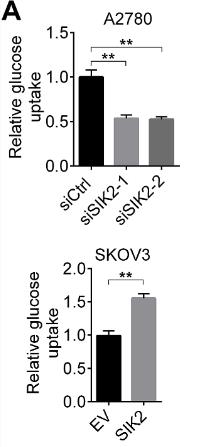
Fig1. Relative glucose uptake was determined in A2780 and SKOV3 cells with treatment as indicated.
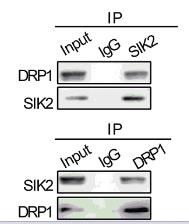
Fig2. Co-IP assay was performed with anti-SIK2 or anti-DRP1 antibody.
Case Study 2: Jing Zhao, 2020
A recent study has reported that SIK2 is required for adipocyte-induced ovarian cancer (OC) survival through facilitating fatty acid oxidation. However, whether SIK2 also plays a role in the lipid synthesis in OC cells remains elusive. Here, SIK2 significantly promoted the lipid synthesis in OC cells. On the one hand, SIK2 enhanced fatty acid synthesis through upregulating the expression of sterol regulatory element binding protein 1c (SREBP1c) and thus the transcription of major lipogenic enzyme FASN. On the other hand, SIK2 promoted cholesterol synthesis through upregulating the expression of sterol regulatory element binding protein 2 (SREBP2) and thus the transcription of major cholesterol synthesis enzymes HMGCR. Moreover, in vitro and in vivo assays indicated that the SIK2-regulated fatty acid and cholesterol synthesis played a critical role in the growth of OC cells.

Fig3. Western blot analyses of SIK2 expression in ovarian cancer A2780 and SKOV3 cells.
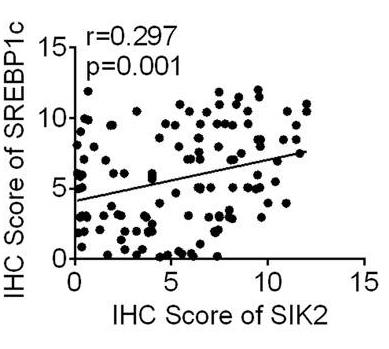
Fig4. Spearman correlation analysis of the relationships between the protein expression levels of SIK2 and SREBP1c based on the IHC staining results.
Quality Guarantee
Involved Pathway
SIK2 involved in several pathways and played different roles in them. We selected most pathways SIK2 participated on our site, such as , which may be useful for your reference. Also, other proteins which involved in the same pathway with SIK2 were listed below. Creative BioMart supplied nearly all the proteins listed, you can search them on our site.
| Pathway Name | Pathway Related Protein |
|---|
Protein Function
SIK2 has several biochemical functions, for example, ATP binding,magnesium ion binding,protein binding. Some of the functions are cooperated with other proteins, some of the functions could acted by SIK2 itself. We selected most functions SIK2 had, and list some proteins which have the same functions with SIK2. You can find most of the proteins on our site.
| Function | Related Protein |
|---|---|
| protein binding | ZBTB16,TCF7,SYT17,PRPF31,HMGN2,MTDH,S1PR3,SEPT11,KRT81,MOS |
| ATP binding | CARKD,PRKCG,DDX20,FLAD1,PKN2,KIF6,BMPR2A,GUCY2F,RTCD1,DYNC1LI2 |
| protein serine/threonine kinase activity | CAMK2D2,ZAK,STK31,MAPKAPK2,NEK3,TSSK4,CAMKK1B,BMPR1A,TGFBR1,NIM1K |
| magnesium ion binding | IDH2,CERK,CDC42BPA,RPS6KAL,ITPK1,PKMB,MAP2K7,STK38L,ADSS,FDXACB1 |
Interacting Protein
SIK2 has direct interactions with proteins and molecules. Those interactions were detected by several methods such as yeast two hybrid, co-IP, pull-down and so on. We selected proteins and molecules interacted with SIK2 here. Most of them are supplied by our site. Hope this information will be useful for your research of SIK2.
CEP250;GABARAPL2;PPP2R2B;linkable pd173955 analogue;bosutinib;imatinib;dasatinib;midostaurin;BAG2;HSPB1;PPP2R1B;FUS
SIK2 Related Signal Pathway
Resources
Related Services
Related Products
References

.jpg)
.jpg)
